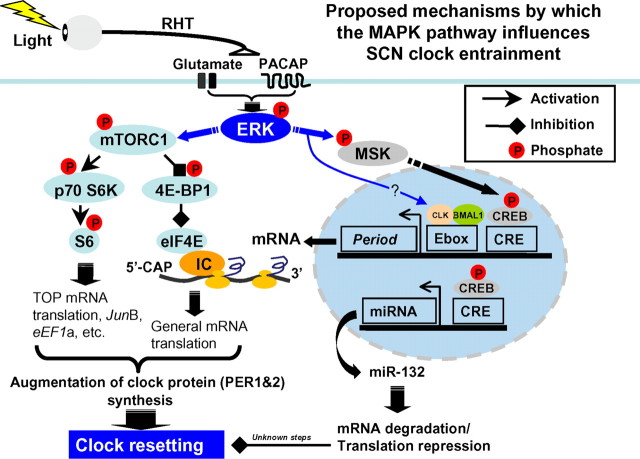Figure 11.
Schematic overview of MAPK-regulated processes that are thought to couple light to the SCN clock during the early night. Photic input from the RHT drives the release of the excitatory amino acid glutamate and the neuropeptide PACAP. Postsynaptic receptors trigger actuation of the MAPK signaling cassette, ultimately leading to the phosphoactivation of the effector kinase ERK. Two principal ERK-mediated signaling events are depicted: activation of MSK and the mTORC1 signaling complex. A potential signaling pathway from ERK to CLOCK (CLK) is also depicted (Weber et al., 2006). Signaling through MSK leads to activation of transcription factors such as CREB (Vermeulen et al., 2009), which in turn drives the induction of early response genes, including c-fos and the clock gene Period1, and potentially Period2 (Travnickova-Bendova et al., 2002). CREB also stimulates the expression of the microRNA miR-132, which works through an as yet unidentified mechanism to limit the resetting effects of light (Cheng et al., 2007). ERK-dependent activation of mTORC1 causes phosphorylation-dependent activation of a p70 S6K/S6 signaling cassette, which stimulates TOP mRNA translation, and a 4E-BP1 and eEF1A signaling cassette, which increases CAP-dependent translation. These two arms of the mTOR pathway work in conjunction to enhance the rate of mRNA processivity. With respect to clock entrainment, we posit that the ERK-dependent transcription (via MSK/CREB) and ERK-dependent translation facilitation (via the mTOR pathway) lead to a robust induction of the PERIOD protein expression. As a state variable of the clock (Reppert and Weaver, 2002), the induction of PERIOD leads to a rapid resetting of the molecular oscillator.

